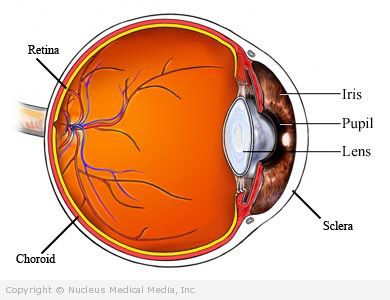Presbyopia – Definition
Presbyopia is the inability to focus on and clearly see objects that are at a normal reading distance or closer.
Presbyopia – Causes
Presbyopia is caused by an age-related, gradual loss of flexibility within the lens of the eye. Because the lens is less elastic, it cannot adequately change its shape to sharply focus on objects at close distances.
Presbyopia – Risk Factors
A risk factor is something that increases your chance of getting a disease or condition.
Risk factors for presbyopia include:
- Age: over 40 years old
- Family members with early onset presbyopia
Presbyopia – Symptoms
Symptoms include:
- Having to hold items further away (at arm’s length) to focus on them
- Blurred vision when reading
- Eye fatigue, discomfort, or drowsiness when doing close-up work such as:
- Reading
- Needlepoint
- Computer work
- Symptoms often made worse by over-tiredness or stress
Presbyopia – Diagnosis
A vision specialist will ask about your symptoms and medical history, and perform an eye exam. You will be asked to read materials at your normal reading distance while the doctor places different lenses in front of your eyes. This test determines the extent of your presbyopia.
Presbyopia – Treatment
Presbyopia is usually treated with corrective lenses. Lens options include:
Glasses
If you already wear glasses, you may need a second set for reading and other close-up activities.
Bifocals combine two prescriptions into one pair of glasses. The upper half of bifocals corrects distance vision and the bottom half corrects close-up vision.
Trifocals are similar to bifocals, except that they have a medium range lens between the distance and near portions to help with intermediate vision tasks.
Another option is progressive lenses, which provide a gradual increase in reading prescription as you look down on the lens. This provides a range of correction for you to use depending on the distance between you and the object you are trying to look at.
If you currently do not need vision correction for distance, then you will only need a pair of glasses to correct your up-close vision. However, some people with perfect distance vision still opt to wear bifocals that are clear on top and have the reading prescription on the bottom so that they can wear them all the time rather than having to put glasses on and off to read.
Contact Lenses
Bifocal contact lenses are available and act the same way as bifocal glasses, with an area for distance and an area for near vision correction. Another option is monovision contact lenses. One eye wears a lens to correct distance vision and the other to correct near vision.
Reading Glasses
If you do not need glasses for distance, you can sometimes buy reading glasses without a prescription. These are typically available in drug stores, discount stores, and vision centers. They are made in increments of 0.25 magnification. The typical range of correction needed is from +1.00 to + 3.00. It is important to get the lowest strength that meets your needs. Anything stronger can cause headaches and eye fatigue.
However, even if you use these glasses, it is still important for you to get a comprehensive eye examination regularly. Also, these glasses are not custom made to correct for the specific distance between your eyes. While they work well for the “average” person, they may not work well for you. If you feel uncomfortable while wearing over-the-counter reading glasses, be sure to see your eye doctor.
Conductive Keratoplasty
Conductive keratoplasty (CK) is a procedure performed by an ophthalmologist to correct presbyopia in one eye. The surgeon places a small probe that emits radiofrequency energy into the cornea to reshape it. This is performed in one eye only. The other eye is dominant for distance vision and the eye receiving the CK is focused for near vision.
Multifocal Intraocular Lenses
Multifocal intraocular lenses can be placed inside the eye in place of the eye’s natural lens. This is typically performed at the time of cataract surgery. The multifocal lens focuses on both distant and near objects simultaneously, often eliminating the need for glasses.
Presbyopia – Prevention
Presbyopia is thought to be an inevitable part of the aging process. Currently, there are no guidelines for preventing it or delaying its onset.

